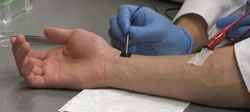Inhibiting Autophagy Later in Life To Extend Lifespan and Quality of Life

Researchers at the Institute of Molecular Biology (IMB) in Mainz have made a breakthrough in understanding the origin of the aging process. They have identified that genes belonging to a process called autophagy, which is one of the cells most critical survival processes, promote health and fitness in young worms but drive the process of aging later in life. This research published in the journal Genes & Development gives some of the first clear evidence for how the aging process arises as a quirk of evolution. The researchers show that by promoting longevity through shutting down autophagy in old worms there is a strong improvement in neuronal and subsequent whole body health.
Getting old is something that happens to everyone and nearly every species on this planet, but the question is: should it? In a recent publication in the journal Genes & Development titled “Neuronal inhibition of the autophagy nucleation complex extends lifespan in post-reproductive C. elegans,” Dr. Holger Richly’s lab at IMB has found some of the first genetic evidence that may put this question to rest.
According to Jonathan Byrne, co-lead author of the paper: “These AP genes had not been found before because it is incredibly difficult to work with already old animals. We were the first to figure out how to do this on a large scale. From a relatively small screen, we found a surprisingly large number of genes that seem to operate in an antagonistic fashion.” Previous studies had found genes that encourage aging while still being essential for development, but the 30 genes the IMB researchers found represent some of the first found promoting aging specifically only in old worms. “Considering we tested only 0.05 percent of all the genes in a worm this suggests there could be many more of these genes out there to find,” stated Byrne.
According to Thomas Wilhelm, the other co-lead author of the paper. “What was most surprising was what processes those genes were involved in.” Not content to provide just the missing evidence for a 60-year-old puzzle, Wilhelm and his colleagues went on to describe what a subset of these genes do in C. elegans and how they might be driving the aging process. “This is where the results really get fascinating,” emphasized Dr. Holger Richly, the principal investigator of the study. “We found a series of genes involved in regulating autophagy, which accelerate the aging process.” These results are surprising indeed as the process of autophagy is a critical recycling process in the cell and is usually required to live a normal full lifetime. Autophagy is known to become slower with age and the authors of this paper show that it appears to completely deteriorate in older worms. They demonstrate that shutting down key genes in the initiation of the process allows the worms to live longer compared with leaving it running crippled. “This could force us to rethink our ideas about one of the most fundamental processes that exist in a cell,” Richly explained. “Autophagy is nearly always thought of as beneficial even if it is barely working. We instead show that there are severe negative consequences when it breaks down and then you are better off bypassing it all together. It is classic AP: in young worms, autophagy is working properly and is essential to reach maturity, but after reproduction it starts to malfunction causing the worms to age,” he continued.
In a final revelation, Richly and his team were able to track the source of the pro longevity signals to a specific tissue, namely the neurons. By inactivating autophagy in the neurons of old worms they were not only able to prolong the worms life but they increased the total health of the worms dramatically. “Imagine reaching the halfway point in your life and getting a drug that leaves you as fit and mobile as someone half your age and you even live longer. That is what it is like for the worms,” said Thomas Wilhelm. “We turn autophagy off only in one tissue and the whole animal gets a boost. The neurons are much healthier in the treated worms and we think this keeps the muscles and the rest of the body in good shape. The net result is a 50 percent extension of life.”
While the authors do not yet know the exact mechanism causing the neurons to stay healthier for longer, this finding could have wide implications. “It is possible that these autophagy genes could represent a good way to help preserve neuronal integrity in these cases,” elaborated Thomas Wilhelm. While any such treatment would be a long way off, assuming such findings could be recapitulated in humans it offers a tantalising hope for being able to prevent disease and get younger and healthier while doing so.
Reference: Thomas Wilhelm, Jonathan Byrne, Rebeca Medina, Ena Kolund?i?, Johannes Geisinger, Martina Hajduskova, Baris Tursun, Holger Richly. Neuronal inhibition of the autophagy nucleation complex extends life span in post-reproductive C. elegans. Genes & Development, 2017; 31 (15): 1561 DOI: 10.1101/gad.301648.117











